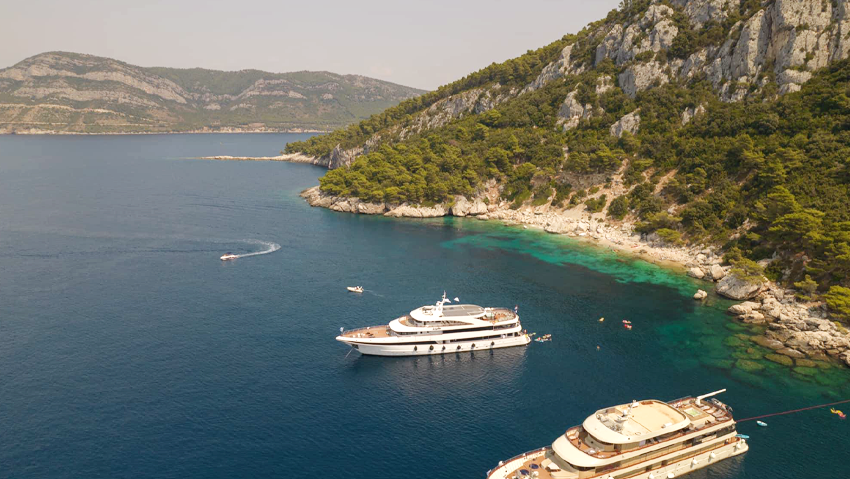
If you're a frequent traveler to Europe and you haven't been to Croatia, it's time to ask yourself, "Why Not?" Croatia is a wondrous Adriatic jewel that is still a young country, after awakening and fighting for liberation from the former Yugoslavia in 1995. After being featured prominently as the set for much of the Game of Thrones series, tourism is booming. Croatia is a top destinations for people who love blue tranquil waters and cruising.
Croatia has the perfect conditions for growing wine grapes — the “C” shaped country overlooking the Adriatic Sea shares latitudes with Italy (from Trieste and Venice in the North down to Abruzzo) and Southern France, and winemaking in the country goes back for since before the Roman times.
Interestingly, Croatia is not one of the first countries we consider when discussing fine wine. Well, that changes today because winemakers in Croatia make beautiful wines that can surely make your wine journey much more interesting! Here’s our quick guide to the wines of Croatia, from the most popular grapes to the best wines in Croatia for all budgets and preferences.

The History of Croatian Wine
Viticulture in the Mediterranean Coast and the area we know now as Croatia goes back to the Phoenicians at least two thousand years ago. Still, some sources suggest grapevines thrived in the area in the Bronze Age, three thousand years ago. We know some of the oldest viticultural are in modern day Iran (near Shiraz) and Georgia. Trade routes from the Euphrates River and Caucasus region must have passed through modern day Croatia en route to Western Europe. There’s no doubt by the time the Romans dominated Europe, Croatia was a considerable wine source.
In the 15th century, the Ottoman Turks dominated the area and restricted alcohol production and consumption. The country’s wine scene resurfaced in the 19th century, although the Croatian vineyards weren’t spared from the devastating phylloxera vine pest.
Croatia fell under communist rule in the mid-20th century, and wine production focused on quantity and not quality. Much of the mass produced wine was sold to Russia. Croatia’s wine traditions might be ancient, but its wine industry is one of the youngest in Europe. Croatia became independent only in 1991.
Croatia’s Wine Industry
Croatia’s current wine production is focused on white wine. Around 67% of the country’s production is dry white wine, followed by red wine with 32%. White wine is the star. Croatia is not about producing copious amounts of wine; the country ranks 32nd in the list of wine-producing countries; it produces around 45,000 tons of wine per vintage, equivalent to only 1% of what France, Spain or Italy make in the same period.
Since its independence, wine production has become a cornerstone of Croatia’s economy, and wine tourism is noteworthy in the verdant country. Of course, Croatians love their wine, and there’s not enough to get around — the country’s wine imports are four times higher than its exports. Given Croatia’s proximity to the sea and the Mediterranean, it’s not surprising that the diet is rich in fish and seafood, which ideally pair with the white wines.
Wine Grapes in Croatia
Croatia’s wine production might be small, but grape growers in the country cultivate over 80 different grapes, red and white — some of them are local specialties not found anywhere else.
Malvasia Istriana is one of the most widely available white wines and comes from the Istrian peninsula in the northwestern region of Croatia. The northern part of this area borders Italy and is a short drive to Trieste. Malvasia Istriana differs from the highly aromatic version found in the Collio. Similar to Moscato, Malvasia is an ancient grape and there are hundreds of known varieties that although related, are distinct. Malvasia Istriana can make simple white table wine or in the hands of talented winemakers, it can be made into excellent wines with the ability to age 10+ years. Some of the reserve versions we tried that were aged in French oak were outstanding.
Grk is a white wine grape with a funny name from the island of Korcula. It is high in acidity, often expresses a light brine or salinity, and a hint of pine. The name derives from the Croatian word for "bitter." Interestingly, this grape has only female flowers and the vineyards must be interspersed with male vines such as Plavic Mali. Grk has great potential and it's worth seeking out.
Posip is another white wine varietal from Korcula with outstanding potential. This is perhaps the most common white wine to find in restaurants along the coast. Posip is light to medium bodies and typically fermented in stainless tanks and intended to be drunk within 2-3 years of bottling. There is a wonderful lemon-lime citrus and a hint of spearmint. Highly recommended.
Grasevina (Welschriesling) is one of the most planted white grapes in Croatia, a slightly aromatic, high acidity grape. Otherlocal white grapes are Bogdanusa and Vugava.
Plavic Mali is a complicated grape with many phenotypes. In general, the grape ripens unevenly, is robust with moderate tannins and often produces rustic wines. The flavors are dried strawberry and dried cherry fruit. Although Plavic Mali is very popular in the southern area near Dubrovnik, it doesn't seem to age well and many producers are using too much oak when aging the "Reserve" level wines.
Crljenak Kaštelanski is another related red grape, known as Primitivo in Southern Italy and Zinfandel in California.
International varieties, such as Cabernet Sauvignon, Merlot, Chardonnay, Sauvignon Blanc and Riesling, have found their way to Croatia’s vineyards and offer a more familiar take on the Mediterranean terroir. We found a fantastic Pinot Noir from the North central region of Croatia one a recent visit.
Croatia’s Wine Regions
Croatia has vineyards along its coast and further inland. Coastal Croatia, known as Primorska Hrvatska, is the most significant for the quality of the wine produced on the Dalmatian Coast and Istria.
The Alps divide Croatia. On one side you have the coast, and on the other, Continental Croatia, which is hillier and colder than the warm coast. The inland vineyards are divided into Eastern Continental (Istočna kontinentalna) and Western Continental (Zapadna kontinentalna). Each region has thriving subregions, showing Croatia has many micro-climates, each specializing in particular wine grapes and styles. It is still soon to know which subregions will stand out in the future, but promising wines are coming from all around the country. These inland regions benefit from the altitude and cooler climates.

Wine Laws in Croatia
Croatia is still working on its own version of Europe’s appellation system, so there are yet to be regions at an AOP or IGP level. Still, the country’s wine has distinct quality tiers, which might help wine enthusiasts worldwide find the best wines in Croatia.
Wines labeled with the term Vrhunsko Vino are of premium quality and are often concentrated wines with complex bouquets. Wines labeled as Kvalitetno Vino are medium-quality and best suited for casual occasions. Wine labeled as Stolno Vino is table wine and could be a nice everyday wine. Finally, the term Arhiv is Croatia’s version of Reserve wines, and they’re often cellar-worthy.

Croatian Wine, A Hidden Gem
Croatian wine might not enjoy the popularity of neighboring countries, but there’s no doubt talented and enthusiastic winemakers around the country making extraordinary wine in all styles.
Wine from Croatia represents amazing value and is a unique take on the acclaimed Mediterranean terroir. Add Croatian wine to your repertoire, if you can find it, and treat yourself to an authentic, hidden gem in the world of wine.
Big Hammer Wines
The wine experts at Big Hammer Wines taste thousands of wines every year from around the globe, looking for quality and value. This special offer reflects the passion we have for our clients.
Discover the world through its wines, Click Here! Visit Bighammerwines.com and become a wine expert!
Leave a comment (all fields required)
Comments will be approved before showing up.


